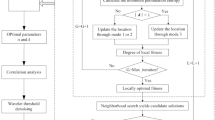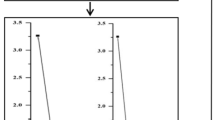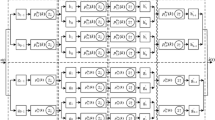Abstract
Vibration analysis is an effective approach to evaluate hob wear status and diagnose hob faults. However, the extraction of vibration signal features is susceptible to noise interference. To solve this problem, a method combining grey relational analysis (GRA) and variational mode decomposition (VMD), named GVMD, is proposed in this paper. In our method, the mode number K, the most important parameter of VMD, can be adaptively determined by GRA. After VMD decomposition, GRA is again used to distinguish noise-dominant modes and signal-dominant modes, in which noise-dominant modes are processed by soft thresholding method. Then, the processed noise-dominant modes and signal-dominant modes are reconstructed to obtain the denoised signal, and signal features can be accurately extracted. In experiments, simulation signals, hob wear vibration signals and hob broken tooth vibration signals are used to evaluate performance of GVMD and other methods. The results demonstrate that GVMD achieves better results than other methods. GVMD can eliminate noise interference and effectively extract signal features.
















Similar content being viewed by others
References
Liu, Z.W.; He, Z.J.; Guo, W.; Tang, Z.C.: A hybrid fault diagnosis method based on second generation wavelet de-noising and local mean decomposition for rotating machinery. ISA Trans. 61, 211–220 (2016)
Zheng, K.; Luo, J.F.; Zhang, Y.; Li, T.L.; Wen, J.F.; Xiao, H.: Incipient fault detection of rolling bearing using maximum autocorrelation impulse harmonic to noise deconvolution and parameter optimized fast EEMD. ISA Trans. 89, 256–271 (2019)
Hu, C.F.; Wang, Y.X.: Multidimensional denoising of rotating machine based on tensor factorization. Mech. Syst. Signal Process. 122, 273–289 (2019)
Sadooghi, M.S.; Khadem, S.E.: A new performance evaluation scheme for jet engine vibration signal denoising. Mech. Syst. Signal Process. 76–77, 201–212 (2016)
Chen, Y.L.; Zhang, P.L.; Wang, Z.J.; Yang, W.C.; Yang, Y.D.: Denoising algorithm for mechanical vibration signal using quantum Hadamard transformation. Measurement 66, 168–175 (2015)
Yue, G.D.; Cui, X.S.; Zou, Y.Y.; Bai, X.T.; Wu, Y.H.; Shi, H.T.: A Bayesian wavelet packet denoising criterion for mechanical signal with non-Gaussian characteristic. Measurement 138, 702–712 (2019)
Dudik, J.M.; Coyle, J.L.; EI-Jaroudi, A.; Sun, M.G.; Sejdic, E.: A matched dual-tree wavelet denoising for tri-axial swallowing vibrations. Biomed. Signal Process. Control 27, 112–121 (2016)
Bi, F.R.; Ma, T.; Wang, X.: Development of a novel knock characteristic detection method for gasoline engines based on wavelet-denoising and EMD decomposition. Mech. Syst. Signal Process. 117, 517–536 (2019)
Wang, H.C.; Chen, J.; Dong, G.G.: Feature extraction of rolling bearing’s early weak fault based on EEMD and tunable Q-factor wavelet transform. Mech. Syst. Signal Process. 48, 103–119 (2014)
Huang, N.E.; Shen, Z.; Long, S.R.; Wu, M.C.; Shih, H.H.; Zheng, Q.; Yen, N.C.; Tung, C.C.; Liu, H.H.: The empirical mode decomposition and the Hilbert spectrum for nonlinear and non-stationary time series analysis. Proc. A 454, 903–995 (1998)
Yang, G.; Liu, Y.; Wang, Y.; Zhu, Z.: EMD interval thresholding denoising based on similarity measure to select relevant modes. Signal Process. 109, 95–109 (2015)
Ma, B.; Zhang, T.: Single-channel blind source separation for vibration signals based on TVF-EMD and improved SCA. IET Signal Proc. 14(4), 259–268 (2020)
Lu, W.Q.; Zhang, L.B.; Liang, W.; Yu, X.C.: Research on a small-noise reduction method based on EMD and its application in pipeline leakage detection. J. Loss Prev. Process Ind. 41, 282–293 (2016)
Wu, Z.H.; Huang, N.E.: Ensemble empirical mode decomposition: a noise assisted data analysis method. Adv. Adapt. Data Anal. 1, 1–41 (2019)
Wang, W.Y.; Chen, Q.J.; Yan, D.L.; Geng, D.Z.: A novel comprehensive evaluation method of the draft tube pressure pulsation of Francis turbine based on EEMD and information entropy. Mech. Syst. Signal Process. 116, 772–786 (2019)
Peng, Y.X.; Liu, Y.S.; Zhang, C.; Wu, L.: Ensemble EMD-based signal denoising using modified interval thresholding. Arab. J. Sci. Eng. (2021)
Mariyappa, N.; Sengottuvel, S.; Parasakthi, C.; Gireesan, K.; Janawadkar, M.P.; Radhakrishnan, T.S.; Sundar, C.S.: Baseline drift removal and denoising of MCG data using EEMD: Role of noise amplitude and the thresholding effect. Med. Eng. Phys. 36, 1266–1276 (2014)
Liu, Y.Y.; Yang, G.L.; Li, M.; Yin, H.L.: Variational mode decomposition denoising combined the detrended fluctuation analysis. Signal Process. 125, 349–364 (2016)
Dragomiretskiy, K.; Zosso, D.: Variational mode decomposition. IEEE Trans. Signal Process 62, 531–544 (2014)
Zhang, Y.G.; Chen, B.; Pan, G.F.; Zhao, Y.: A novel hybrid model based on VMD-WT and PCA-BP-RBF neural network for short-term wind speed forecasting. Energy Convers. Manage. 195, 180–197 (2019)
Li, J.M.; Yao, X.F.; Wang, H.; Zhang, J.F.: Periodic impulses extraction based on improved adaptive VMD and sparse code shrinkage denoising and its application in rotating machinery fault diagnosis. Mech. Syst. Signal Process. 126, 568–589 (2019)
Xiao, Q.Y.; Li, J.; Zeng, Z.M.: A denoising scheme for DSPI phase based on improved variational mode decomposition. Mech. Syst. Signal Process. 110, 28–41 (2018)
Abdoos, A.A.: A new intelligent method based on combination of VMD and ELM for short term wind power forecasting. Neurocomputing 203, 111–120 (2016)
Hu, H.P.; Zhang, L.M.; Yan, H.C.; Bai, Y.P.; Wang, P.: Denoising and baseline drift removal method of MEMS hydrophone signal based on VMD and wavelet threshold processing. IEEE Access 7, 59913–59922 (2019)
Xiao, F.Y.; Yang, D.C.; Guo, X.H.; Wang, Y.: VMD-based denoising methods for surface electromyography signals. J. Neural Eng. 16(5), 056017 (2019)
Zhang, J.; He, J.; Long, J.; Yao, M.; Zhou, W.: A new denoising method for UHF PD signals using adaptive VMD and SSA-based shrinkage method. Sensors 19, 7 (2019)
Ren, H.; Liu, W.Y.; Shan, M.C.; Wang, X.: A new wind turbine health condition monitoring method based on VMD-MPE and feature-based transfer learning. Measurement 148, (2019)
Si, D.; Gao, B.; Guo, W.; Yan, Y.; Tian, G.Y.; Yin, Y.: Variational mode decomposition linked wavelet method for EMAT denoise with large lift-off effect. NDT & E Int. 107, (2019)
Lu, J.Y.; Yue, J.K.; Zhu, L.J.; Li, G.F.: Variational mode decomposition denoising combined with improved Bhattacharyya distance. Measurement 151, 02632241 (2020)
Cui, J.; Yu, R.Z.; Zhao, D.B.; Yang, J.Y.; Ge, W.C.; Zhou, X.M.: Intelligent load pattern modeling and denoising using improved variational mode decomposition for various calendar periods. Appl. Energy 247, 480–491 (2019)
Li, J.; Chen, Y.; Qian, Z.H.; Lu, C.G.: Research on VMD based adaptive denoising method applied to water supply pipeline leakage location. Measurement 151, 02632241 (2020)
Deng, J.L.: Control problems of grey systems. Syst. Control Lett. 1, 288–294 (1982)
Deng, J.L.: Introduction to grey system theory. J. Grey Syst. 1, 1–24 (1989)
Li, H.J.; Suen, C.Y.: A novel Non-local means image denoising method based on grey theory. Pattern Recogn. 49, 237–248 (2016)
Wojciechowski, S.; Maruda, R.W.; Krolczyk, G.M.; Niesłony, P.: Application of signal to noise ratio and grey relational analysis to minimize forces and vibrations during precise ball end milling. Precis. Eng. 51, 582–596 (2018)
Kanchana, J.; Prasath, V.; Krishnaraj, V.; Geetha, P.B.: Multi response optimization of process parameters using grey relational analysis for milling of hardened Custom 465 steel. Procedia Manufact. 30, 451–458 (2019)
Yadav, S.K.; Yadav, S.K.: Optimization of machining parameters during the ECCDG of inconel 718 using PCA based grey relational analysis. Materials Today: Proceedings (2020)
Wang, H.; Zhang, Y.M.; Yang, Z.: A risk evaluation method to prioritize failure modes based on failure data and a combination of fuzzy sets theory and grey theory. Eng. Appl. Artif. Intell. 82, 216–225 (2019)
Canbolat, A.S.; Bademlioglu, A.H.; Arslanoglu, N.; Kaynakli, O.: Performance optimization of absorption refrigeration systems using Taguchi, ANOVA and Grey Relational Analysis methods. J. Clean. Prod. 229, 874–885 (2019)
Li, X.Y.; Wang, Z.P.; Zhang, L.; Zou, C.F.; Dorrell, D.D.: State-of-health estimation for Li-ion batteries by combing the incremental capacity analysis method with grey relational analysis. J. Power Sour. 410, 106–114 (2019)
Wu, D.L.; Zhou, P.; Zhou, C.Q.: Evaluation of pulverized coal utilization in a blast furnace by numerical simulation and grey relational analysis. Appl. Energy 250, 1686–1695 (2019)
Arıcı, E.; Kelestemur, O.: Optimization of mortars containing steel scale using Taguchi based grey relational analysis method. Constr. Build. Mater. 214, 232–241 (2019)
Wu, Y.L.; Zhou, F.; Kong, J.Z.: Innovative design approach for product design based on TRIZ, AD, fuzzy and Grey relational analysis. Computers & Industrial Engineering 140, (2020)
Terrien, J.; Marque, C.; Karlsson, B.: Automatic detection of mode mixing in empirical mode decomposition using non-stationarity detection: Application to selecting IMFs of interest and denoising. J. Adv. Signal Process. 2011(1), 37–44 (2011)
Acknowledgements
The research work reported in this paper was supported by the National Key Research and Development Project (No. 2019YFB1703700).
Author information
Authors and Affiliations
Corresponding author
Rights and permissions
About this article
Cite this article
Jia, Y., Li, G. & Dong, X. Feature Extraction of Hob Vibration Signals Using Denoising Method Combining VMD and Grey Relational Analysis. Arab J Sci Eng 47, 2925–2942 (2022). https://doi.org/10.1007/s13369-021-05951-7
Received:
Accepted:
Published:
Issue Date:
DOI: https://doi.org/10.1007/s13369-021-05951-7




